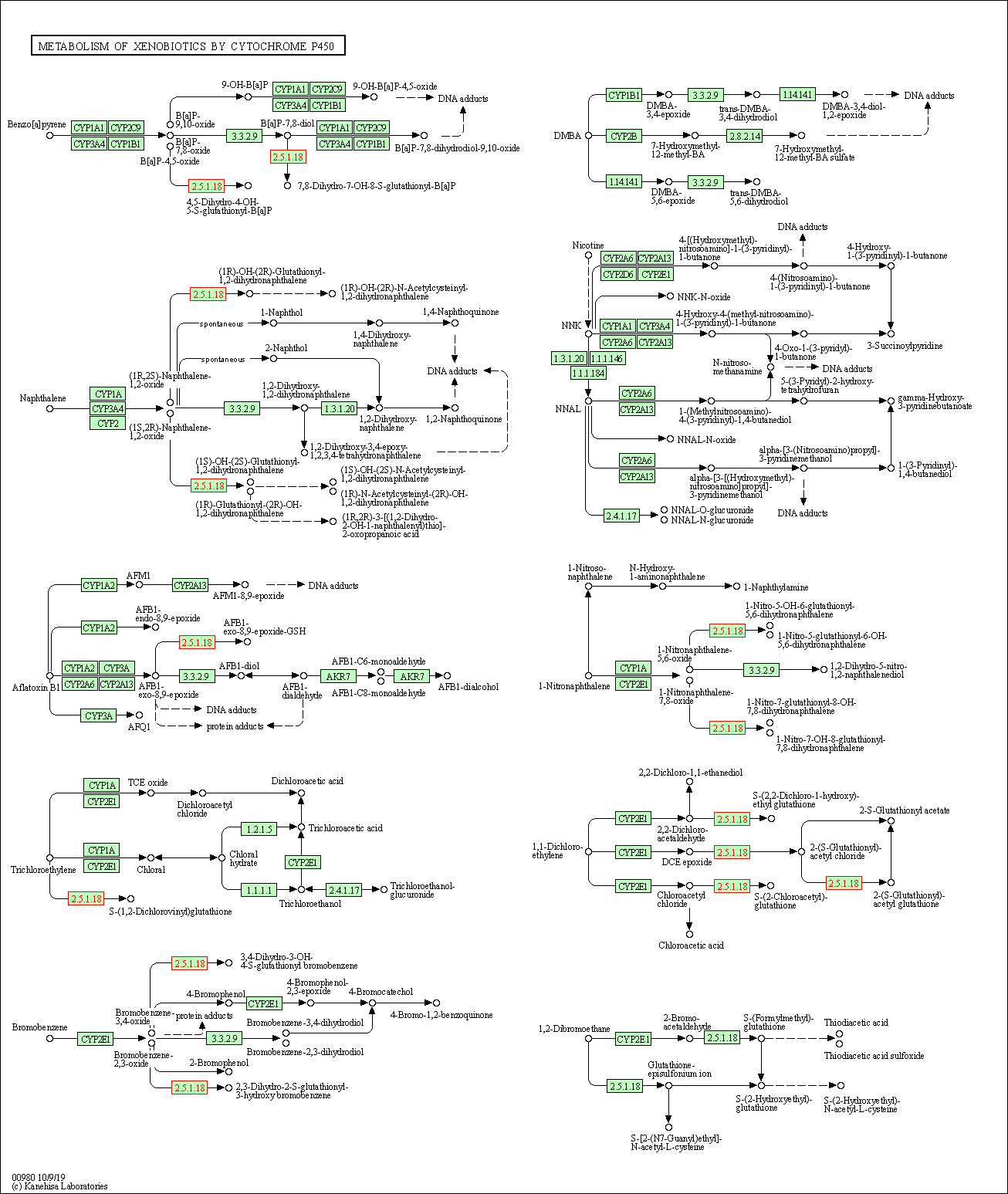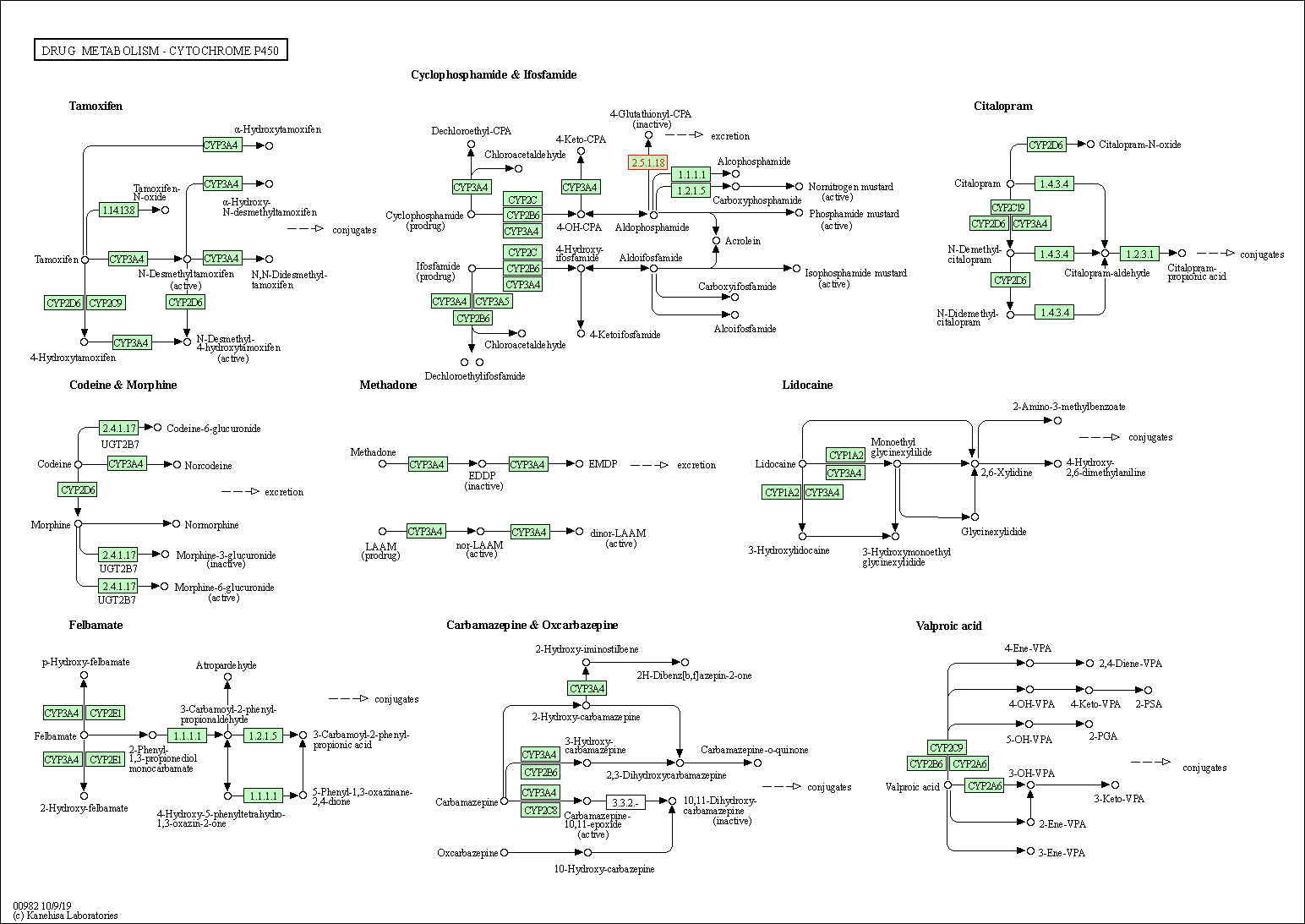Target Information
| Target General Information | Top | |||||
|---|---|---|---|---|---|---|
| Target ID |
T21669
(Former ID: TTDI02088)
|
|||||
| Target Name |
Glutathione S-transferase P (GSTP1)
|
|||||
| Synonyms |
GSTP11; GSTP1-1; GST3; GST classpi; GST class-pi; FAEES3
Click to Show/Hide
|
|||||
| Gene Name |
GSTP1
|
|||||
| Target Type |
Clinical trial target
|
[1] | ||||
| Disease | [+] 1 Target-related Diseases | + | ||||
| 1 | Solid tumour/cancer [ICD-11: 2A00-2F9Z] | |||||
| Function |
Regulates negatively CDK5 activity via p25/p35 translocation to prevent neurodegeneration. Conjugation of reduced glutathione to a wide number of exogenous and endogenous hydrophobic electrophiles.
Click to Show/Hide
|
|||||
| BioChemical Class |
Alkyl aryl transferase
|
|||||
| UniProt ID | ||||||
| EC Number |
EC 2.5.1.18
|
|||||
| Sequence |
MPPYTVVYFPVRGRCAALRMLLADQGQSWKEEVVTVETWQEGSLKASCLYGQLPKFQDGD
LTLYQSNTILRHLGRTLGLYGKDQQEAALVDMVNDGVEDLRCKYISLIYTNYEAGKDDYV KALPGQLKPFETLLSQNQGGKTFIVGDQISFADYNLLDLLLIHEVLAPGCLDAFPLLSAY VGRLSARPKLKAFLASPEYVNLPINGNGKQ Click to Show/Hide
|
|||||
| 3D Structure | Click to Show 3D Structure of This Target | PDB | ||||
| HIT2.0 ID | T46AQJ | |||||
| Drugs and Modes of Action | Top | |||||
|---|---|---|---|---|---|---|
| Clinical Trial Drug(s) | [+] 2 Clinical Trial Drugs | + | ||||
| 1 | Canfosfamide | Drug Info | Phase 3 | Solid tumour/cancer | [1] | |
| 2 | Ezatiostat | Drug Info | Phase 2 | Myelodysplastic syndrome | [2] | |
| Mode of Action | [+] 1 Modes of Action | + | ||||
| Modulator | [+] 2 Modulator drugs | + | ||||
| 1 | Canfosfamide | Drug Info | [1], [3] | |||
| 2 | Ezatiostat | Drug Info | [4] | |||
| Cell-based Target Expression Variations | Top | |||||
|---|---|---|---|---|---|---|
| Cell-based Target Expression Variations | ||||||
| Drug Binding Sites of Target | Top | |||||
|---|---|---|---|---|---|---|
| Ligand Name: Ethacrynic acid | Ligand Info | |||||
| Structure Description | Crystal structure of the glutathione transferase PI enzyme in complex with the bifunctional inhibitor, etharapta | PDB:3DGQ | ||||
| Method | X-ray diffraction | Resolution | 1.60 Å | Mutation | No | [5] |
| PDB Sequence |
MPPYTVVYFP
9 VRGRCAALRM19 LLADQGQSWK29 EEVVTVETWQ39 EGSLKASCLY49 GQLPKFQDGD 59 LTLYQSNTIL69 RHLGRTLGLY79 GKDQQEAALV89 DMVNDGVEDL99 RCKYISLIYT 109 NYEAGKDDYV119 KALPGQLKPF129 ETLLSQNQGG139 KTFIVGDQIS149 FADYNLLDLL 159 LIHEVLAPGC169 LDAFPLLSAY179 VGRLSARPKL189 KAFLASPEYV199 NLPINGNGKQ 209
|
|||||
|
|
||||||
| Click to View More Binding Site Information of This Target and Ligand Pair | ||||||
| Ligand Name: Sulfasalazine | Ligand Info | |||||
| Structure Description | GLUTATHIONE S-TRANSFERASE COMPLEXED WITH SULFASALAZINE | PDB:13GS | ||||
| Method | X-ray diffraction | Resolution | 1.90 Å | Mutation | No | [6] |
| PDB Sequence |
MPPYTVVYFP
9 VRGRCAALRM19 LLADQGQSWK29 EEVVTVETWQ39 EGSLKASCLY49 GQLPKFQDGD 59 LTLYQSNTIL69 RHLGRTLGLY79 GKDQQEAALV89 DMVNDGVEDL99 RCKYISLIYT 109 NYEAGKDDYV119 KALPGQLKPF129 ETLLSQNQGG139 KTFIVGDQIS149 FADYNLLDLL 159 LIHEVLAPGC169 LDAFPLLSAY179 VGRLSARPKL189 KAFLASPEYV199 NLPINGNGKQ 209
|
|||||
|
|
||||||
| Click to View More Binding Site Information of This Target with Different Ligands | ||||||
| Different Human System Profiles of Target | Top |
|---|---|
|
Human Similarity Proteins
of target is determined by comparing the sequence similarity of all human proteins with the target based on BLAST. The similarity proteins for a target are defined as the proteins with E-value < 0.005 and outside the protein families of the target.
A target that has fewer human similarity proteins outside its family is commonly regarded to possess a greater capacity to avoid undesired interactions and thus increase the possibility of finding successful drugs
(Brief Bioinform, 21: 649-662, 2020).
Human Tissue Distribution
of target is determined from a proteomics study that quantified more than 12,000 genes across 32 normal human tissues. Tissue Specificity (TS) score was used to define the enrichment of target across tissues.
The distribution of targets among different tissues or organs need to be taken into consideration when assessing the target druggability, as it is generally accepted that the wider the target distribution, the greater the concern over potential adverse effects
(Nat Rev Drug Discov, 20: 64-81, 2021).
Human Pathway Affiliation
of target is determined by the life-essential pathways provided on KEGG database. The target-affiliated pathways were defined based on the following two criteria (a) the pathways of the studied target should be life-essential for both healthy individuals and patients, and (b) the studied target should occupy an upstream position in the pathways and therefore had the ability to regulate biological function.
Targets involved in a fewer pathways have greater likelihood to be successfully developed, while those associated with more human pathways increase the chance of undesirable interferences with other human processes
(Pharmacol Rev, 58: 259-279, 2006).
Biological Network Descriptors
of target is determined based on a human protein-protein interactions (PPI) network consisting of 9,309 proteins and 52,713 PPIs, which were with a high confidence score of ≥ 0.95 collected from STRING database.
The network properties of targets based on protein-protein interactions (PPIs) have been widely adopted for the assessment of target’s druggability. Proteins with high node degree tend to have a high impact on network function through multiple interactions, while proteins with high betweenness centrality are regarded to be central for communication in interaction networks and regulate the flow of signaling information
(Front Pharmacol, 9, 1245, 2018;
Curr Opin Struct Biol. 44:134-142, 2017).
Human Similarity Proteins
Human Tissue Distribution
Human Pathway Affiliation
Biological Network Descriptors
|
|
|
There is no similarity protein (E value < 0.005) for this target
|
|
Note:
If a protein has TS (tissue specficity) scores at least in one tissue >= 2.5, this protein is called tissue-enriched (including tissue-enriched-but-not-specific and tissue-specific). In the plots, the vertical lines are at thresholds 2.5 and 4.
|
| KEGG Pathway | Pathway ID | Affiliated Target | Pathway Map |
|---|---|---|---|
| Glutathione metabolism | hsa00480 | Affiliated Target |

|
| Class: Metabolism => Metabolism of other amino acids | Pathway Hierarchy | ||
| Metabolism of xenobiotics by cytochrome P450 | hsa00980 | Affiliated Target |

|
| Class: Metabolism => Xenobiotics biodegradation and metabolism | Pathway Hierarchy | ||
| Drug metabolism - cytochrome P450 | hsa00982 | Affiliated Target |

|
| Class: Metabolism => Xenobiotics biodegradation and metabolism | Pathway Hierarchy | ||
| Drug metabolism - other enzymes | hsa00983 | Affiliated Target |

|
| Class: Metabolism => Xenobiotics biodegradation and metabolism | Pathway Hierarchy | ||
| Degree | 4 | Degree centrality | 4.30E-04 | Betweenness centrality | 2.05E-04 |
|---|---|---|---|---|---|
| Closeness centrality | 2.26E-01 | Radiality | 1.40E+01 | Clustering coefficient | 3.33E-01 |
| Neighborhood connectivity | 5.13E+01 | Topological coefficient | 2.74E-01 | Eccentricity | 11 |
| Download | Click to Download the Full PPI Network of This Target | ||||
| Chemical Structure based Activity Landscape of Target | Top |
|---|---|
| Target Poor or Non Binders | Top | |||||
|---|---|---|---|---|---|---|
| Target Poor or Non Binders | ||||||
| Target Regulators | Top | |||||
|---|---|---|---|---|---|---|
| Target-regulating microRNAs | ||||||
| Target-regulating Transcription Factors | ||||||
| Target-interacting Proteins | ||||||
| Target Profiles in Patients | Top | |||||
|---|---|---|---|---|---|---|
| Target Expression Profile (TEP) | ||||||
| Target Affiliated Biological Pathways | Top | |||||
|---|---|---|---|---|---|---|
| BioCyc | [+] 2 BioCyc Pathways | + | ||||
| 1 | Glutathione-mediated detoxification | |||||
| 2 | 4-hydroxy-2-nonenal detoxification | |||||
| KEGG Pathway | [+] 6 KEGG Pathways | + | ||||
| 1 | Glutathione metabolism | |||||
| 2 | Metabolism of xenobiotics by cytochrome P450 | |||||
| 3 | Drug metabolism - cytochrome P450 | |||||
| 4 | Pathways in cancer | |||||
| 5 | Chemical carcinogenesis | |||||
| 6 | Prostate cancer | |||||
| NetPath Pathway | [+] 1 NetPath Pathways | + | ||||
| 1 | TCR Signaling Pathway | |||||
| References | Top | |||||
|---|---|---|---|---|---|---|
| REF 1 | Mechanism of glutathione transferase P1-1-catalyzed activation of the prodrug canfosfamide (TLK286, TELCYTA). Biochemistry. 2013 Nov 12;52(45):8069-78. | |||||
| REF 2 | ClinicalTrials.gov (NCT01422486) Phase 2 Study of Telintra in Deletion 5q Myelodysplastic Syndrome. U.S. National Institutes of Health. | |||||
| REF 3 | Phase 1 study of TLK286 (Telcyta) administered weekly in advanced malignancies. Clin Cancer Res. 2004 Jun 1;10(11):3689-98. | |||||
| REF 4 | National Cancer Institute Drug Dictionary (drug id 485244). | |||||
| REF 5 | Rational design of an organometallic glutathione transferase inhibitor. Angew Chem Int Ed Engl. 2009;48(21):3854-7. | |||||
| REF 6 | The ligandin (non-substrate) binding site of human Pi class glutathione transferase is located in the electrophile binding site (H-site). J Mol Biol. 1999 Aug 27;291(4):913-26. | |||||
If You Find Any Error in Data or Bug in Web Service, Please Kindly Report It to Dr. Zhou and Dr. Zhang.

